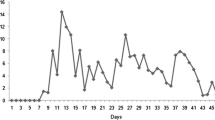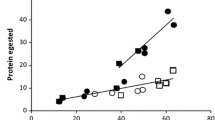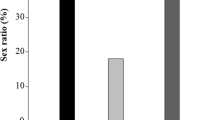Abstract
A series of laboratory no-choice assays were performed to test changes in the feeding, growth, and nutrition of leaf beetle (Agelastica coerulea) larval instars on O3-treated leaves of Japanese white birch (Betula platyphylla var. japonica). Larvae fed with O3-treated leaves grew and developed significantly faster throughout their developmental cycle than the corresponding controls. The growth rate (GR) and consumption index (CI) were mostly decreased with age for both control and O3-treated leaves. Efficiency of conversion of both ingested and digested food (ECI, ECD) showed an increase from the 2nd to the 4th instar, after which they decreased significantly and reached the lowest value in the last larval instars (7th). GR, CI, ECI, and ECD were greater and approximate digestibility (AD) was lower in larvae fed with O3-treated leaves than those fed with control leaves. This indicated that the greater rate of growth on fumigated leaves was due primarily to a greater rate of consumption (i.e., O3 increased the “acceptability” of the host more than “suitability”) and efficiency in converting food into body mass. Overall, larval performance seemed to have improved when fed with O3-treated leaves in these assays. This study suggests that insects may be more injurious to O3-treated plants and warrants further investigations on birch-beetle interactions under field conditions.


Similar content being viewed by others
References
Abu ElEla SA, ElSayed WM (2015) The influence of cadmium on the food consumption and utilization of the cotton leaf worm Spodoptera littoralis (Boisd.) (Lepidoptera: Noctuidae). Ecol Balkan 7:81–85
Abu ElEla SA, Nassar MM, Eesa NN (2016) Impact of lead acetate on quantitative consumption and utilization of the cotton leaf worm, Spodoptera littoralis (Boisduval, 1833) (Lepidoptera: Noctuidae). Ecol Balkan 8:101–106
Adham FK, Gabre RM, Abu El-Ela SA, Hassan MM (2005a) Growth and feeding efficiency of cotton leaf worm Spodoptera littoralis (Boisd.) (Lepidoptera: Noctuidae) on cotton plant Gossypium barbadens (Malvaceae) grown in enriched CO2 atmosphere. Bul Entom Soc Egypt 82:187–196
Adham FK, Gabre RM, Abu El-Ela SA (2005b) The performance parameters of Spodoptera littoralis (Boisd.) (Lepidoptera: Noctuidae) fed on cotton leaves grown in enriched CO2 atmosphere. Bull Entom Soc Egypt 82:197–205
Agathokleous E (2018) Environmental hormesis, a fundamental non-monotonic biological phenomenon with implications in ecotoxicology and environmental safety. Ecotoxicol Environ Saf 148:1042–1053
Agathokleous E, Koike T, Watanabe M, Hoshika Y, Saitanis CJ (2015a) Ethylene-di-urea (EDU), an effective phytoprotectant against O3 deleterious effects and a valuable research tool. J Agric Meteorol 71:185–195
Agathokleous E, Saitanis CJ, Koike T (2015b) Tropospheric O3, the nightmare of wild plants: a review study. J Agric Meteorol 71:142–152
Agathokleous E, Saitanis CJ, Wang X, Watanabe M, Koike T (2016a) A review study on past 40 years of research on effects of tropospheric O3 on belowground structure, functioning and processes of trees: a linkage with potential ecological implications. Water Air Soil Poll 227:33
Agathokleous E, Saitanis CJ, Stamatelopoulos D, Mouzaki-Paxinou A-C, Paoletti E, Manning WJ (2016b) Olive oil for dressing plant leaves so as to avoid O3 injury. Water Air Soil Poll 227:282
Agathokleous E, Sakikawa T, Abu ElEla SA, Mochizuki T, Nakamura M, Watanabe M, Kawamura K, Koike T (2017a) Ozone alters the feeding behavior of the leaf beetle Agelastica coerulea (Coleoptera: Chrysomelidae) into leaves of Japanese white birch (Betula platyphylla var. japonica). Environ Sci Poll Res 24:17577–17583
Agathokleous E, Vanderstock A, Kita K, Koike T (2017b) Stem and crown growth of Japanese larch and its hybrid F1 grown in two soils and exposed to two free-air O3 regimes. Environ Sci Poll Res 24:6634–6647
Ainsworth EA, Yendrek CR, Sitch S, Collins WJ, Emberson LD (2012) The effects of tropospheric ozone on net primary productivity and implications for climate change. Annu Rev Plant Biol 63:637–661
Ali JG, Agrawal AA (2012) Specialist versus generalist insect herbivores and plant defense. Trends Plant Sci 17:293–302
Alstad DN, Edmunds GF Jr, Weinstein LH (1982) Effects of air pollutants on insect populations. Annu Rev Entomol 27:369–384
Blande JD, Holopainen JK, Niinements Ü (2014) Plant volatiles in polluted atmospheres: stress responses and signal degradation. Plant Cell Environ 37:1892–1904
Bolsinger M, Lier ME, Lansky DM, Hughes PR (1991) Influence of ozone air pollution on plant-herbivore interactions. Part 1: biochemical changes in ornamental milkweed (Asclepias curassavica L.; Asclepiadaceae) induced by ozone. Environ Pollut 72:69–83
Bolsinger M, Lier ME, Hughes PR (1992) Influence of ozone air pollution on plant-herbivore interactions. Part 2: effects of ozone on feeding preference, growth and consumption rates of monarch butterflies (Danaus plexippus). Environ Pollut 77:31–37
Box GEP, Cox DR (1964) An analysis of transformations. J R Stat Soc Ser B 26:211–252
Cape JN (2008) Surface ozone concentrations and ecosystem health: Past trends and a guide to future projections. Sci Total Environ 400:257–269
Chappelka AH, Grulke NE (2016) Disruption of the ‘disease triangle’ by chemical and physical environmental change. Plant Biol 18:5–12
Chappelka AH, Kraemer ME, Mebrahtu T, Rangappa M, Benepal PS (1988) Effects of ozone on soybean resistance to the Mexican bean beetle (Epilachna varivestis mulsant). Environ Exp Bot 28:53–66
Cohen A (2015) Insect diets: science and technology, 2nd edn. CRC Press, Florida 473 pp
Cui H, Su J, Wei J, Hu Y, Ge F (2014) Elevated O3 enhances the attraction of whitefly-infested tomato plants to Encarsia formosa. Sci Rep 4:5350
Derwent RG, Simmonds PG, Manning AJ, Spain TG (2007) Trends over a 20-year period from 1987 to 2007 in surface ozone at the atmospheric research station, Mace Head, Ireland. Atmos Environ 41:9091–9098
Dötterl S, Vater M, Rupp T, Held A (2016) Ozone differentially affects perception of plant volatiles in western honey bees. J Chem Ecol 42:486–489
Endress AG, Post SL (1985) Altered feeding preference of Mexican bean beetle Epilachna varivestis for ozonated soybean foliage. Environ Pollut 39:9–16
Farrar RR, Barbour JD, Kennedy GG (1989) Quantifying food consumption and growth in insects. Ann Entomol Soc Am 82:593–598
Farré-Armengol G, Peñuelas J, Li T, Yli-Pirilä P, Filella I, Llusia J, Blande JD (2016) Ozone degrades floral scent and reduces pollinator attraction to flowers. New Phytol 209:152–160
Feng Z, Kobayashi K, Ainsworth E (2008) Impact of elevated ozone concentration on growth, physiology, and yield of wheat (Triticum aestivum L.): a meta-analysis. Glob Chang Biol 14:2696–2708
Firidin B, Mutlu C (2009) Nitrogen utilization pattern and degradation capability of some plant secondary metabolites by Agelastica alni L. (Coleoptera: Chrysomelidae). J Entomol Res Soc 11:2
Freiwald V, Häikiö E, Julkunen-Tiitto R, Holopainen JK, Oksanen E (2008) Elevated ozone modifies the feeding behaviour of the common leaf weevil on hybrid aspen through shifts in developmental, chemical, and structural properties of leaves. Entomol Exp Appl 128:66–72
Fuentes JD, Roulston TH, Zenker J (2013) Ozone impedes the ability of a herbivore to find its host. Environ Res Lett 8:014048
Fuhrer J, Booker F (2003) Ecological issues related to ozone: agricultural issues. Environ Int 29:141–154
Hain FP (1987) Interactions of insects, trees and air pollutants. Tree Physiol 3:93–102
Hemati SA, Naseri B, Ganbalani GN, Dastjerdi HR, Golizadeh A (2012) Effect of different host plants on nutritional indices of the pod borer, Helicoverpa armigera. J Insect Sci 12:55
Hill T, Lewicki P (2006) Statistics: methods and applications: a comprehensive reference for science, industry, and data mining. StatSoft Inc, Tulsa, pp 832
Hillstrom ML, Lindroth RL (2008) Elevated atmospheric carbon dioxide and ozone alter forest insect abundance and community composition. Insect Cons Diver 1:233–241
Hocking RR (2013) Methods and applications of linear models: regression and the analysis of variance, 3rd edn. Wiley, New York, p 720
Hughes PR (1988) Insect populations on host plants subjected to air pollution. In: Heinrichs EA (ed) Plant stress-insect interactions. John Wiley, Chichester, pp 249–319
Japan Meteorological Agency (2017) http://www.jma.go.jp/jma/indexe.html Website accessed on 27th May 2017
Jones CG, Coleman JS (1988a) Plant stress and insect behavior: cottonwood, ozone and the feeding and oviposition preference of a beetle. Oecologia 76:51–56
Jones CG, Coleman JS (1988b) Leaf disc size and insect feeding preference: implications for assays and studies on induction of plant defense. Entom Exp Appl 47:167–172
Kogan M (1986) Bioassays for measuring quality of insect food. In: Miller JR, Miller TA (eds) Insect-plant interactions. Springer-Verlag, New York, pp 155–189
Koike T (1995) Physiological ecology of the growth characteristics of Japanese mountain birch in northern Japan: a comparison with Japanese white birch. In: Box EO, Peet RK, Masuzawa T, Yamada I, Fujiwara K, Maycock PF (eds) Vegetation science in forestry: global perspective based on forest ecosystems of East & Southeast Asia. Kluwer Academic Publishers, Dordrech, pp 409–422
Koike T, Tobita H, Shibata T, Mastuki S, Konno K, Kitao M, Yamashita N, Maruyama Y (2006) Defense characteristics of seral deciduous broad-leaved tree seedlings grown under differing levels of CO2 and nitrogen. Popul Ecol 48:23–29
Koike T, Watanabe M, Hoshika Y, Kitao M, Matsumura H, Funada R, Izuta T (2013) Effects of ozone on forest ecosystems in East and Southeast Asia. In: Matyssek R, Clarke N, Cudlin P, Mikkelsen TN, Tuovinen J-P, Wieser G, Paoletti E (eds) Climate change, air pollution and global challenges. Elsevier Pub, Oxford, pp 371–390
Lacey LA (1997) Manual of techniques in insect pathology. Academic Press, Bath, 409p
Li T, Blande JD, Holopainen JK (2016) Atmospheric transformation of plant volatiles disrupts host plant finding. Sci Rep 6:33851
Lindroth RL (2010) Impacts of elevated atmospheric CO2 and O3 on forests: phytochemistry, trophic interactions, and ecosystem dynamics. J Chem Ecol 36:2–21
Manuwoto S, Scriber JM (1985) Consumption and utilization of experimentally altered corn by southern armyworm: Iron, nitrogen, and cyclic hydroxamates. J Chem Ecol 11:1469–1483
Matsuki S, Sano Y, Koike T (2004) Chemical and physical defense in the early and late leaves in three heterophyllous birch species native to northern Japan. Ann Bot 93:141–147
Mattson WJ, Haack RA (1987) Role of drought in outbreaks of plant-eating insects. Bioscience 37:110–118
Medrano JF, Gall GAE (1975) Food consumption, feed efficiency, metabolic rate and utilization of glucose in lines of Tribolium castaneum selected for 21-day pupa weight. Genetics 83:393–407
Nagashima T, Ohara T, Sudo K, Akimoto H (2010) The relative importance of various source regions on East Asian surface ozone. Atmos Chem Phys 10:11305–11322
Nagashima T, Sudo K, Akimoto H, Kurokawa J, Ohara T (2017) Long-term change in the source contribution to surface ozone over Japan. Atmos Chem Phys 17:8231–8246
Oksanen E, Pandey V, Keski-Saari S, Kontunen-Soppela S, Sharma C (2013) Impacts of increasing ozone on Indian plants. Environ Pollut 177:189–200
Rahmathulla VK, Suresh HM (2012) Seasonal variation in food consumption, assimilation, and conversion efficiency of Indian bivoltine hybrid silkworm, Bombyx mori. J Insect Sci 12:82
Reese JC, Beck SD (1976) Effects of allelochemics on the black cut worm, Agrotis ipsilon; effects of p-benzoquinone, hydroquinone, and duroquinone on larval growth, development, and utilization of food. Ann Entomol Soc Am 69:59–67
Robinson JM, Rowland RA (1996) Carbohydrate and carbon metabolite accumulation responses in leaves of ozone tolerant and ozone susceptible spinach plants after acute ozone exposure. Photos Res 50:103–115
Royal Society (2008) Ground-level ozone in the 21st century: future trends, impacts and policy implications. Science Policy Report 15/08, The Royal Society, London, p 132
Sakikawa T, Oikawa M, Watanabe M, Mao Q, Koike T (2014) The effect of ozone on leaf phenology of white birch (Betula platyphylla var. japonica) grown under free-air ozone exposure. Boreal For Res 62:59–60 (in Japanese)
Sakikawa T, Nakamura M, Watanabe M, Oikawa M, Satoh F, Koike T (2016) Leaf phenology and insect grazing of Japanese white birch saplings grown under free-air ozone exposure. J Agr Meteorol 72:80–84
Sicard P, Serra R, Rossello P (2016) Spatiotemporal trends in ground-level ozone concentrations and metrics in France over the time period 1999–2012. Environ Res 149:122–144
Sicard P, Anav A, De Marco A, Paoletti E (2017) Projected global tropospheric ozone impacts on vegetation under different emission and climate scenarios. Atmos Chem Phys Discuss 17:12177–12196
Slansky JF (1985) Food utilization by insects: interpretation of observed differences between dry weight and energy efficiencies. Entomol Exp Appl 39:47–60
Smith CM, Khan ZR, Pathak DM (1994) Techniques for evaluating insect resistance in crop plants. CRC Press, Boca Raton, p 336
Solomou E, Poupkou A, Bolis S, Zanis P, Lazaridis M, Melas D (2018) Evaluating near-surface ozone levels simulated from MACC global and regional modeling systems in Eastern Mediterranean under the influence of Etesian winds. Atmos Res. https://doi.org/10.1016/j.atmosres.2017.09.010
Tanimoto H (2009) Increase in springtime tropospheric ozone at a mountainous site in Japan for the period 1998–2006. Atmos Environ 43:1358–1363
Tanimoto H, Ohara T, Uno I (2009) Asian anthropogenic emissions and decadal trends in springtime tropospheric ozone over Japan: 1998–2007. Geophys Res Lett 36:L23802
Teimouri N, Sendi JJ, Zibaee A, Khosravi R (2015) Feeding indices and enzymatic activities of carob moth Ectomyelois ceratoniae (Zeller) (Lepidoptera: Pyrallidae) on two commercial pistachio cultivars and an artificial diet. J Saudi Soc Agric Sci 14:76–82
Trieu TT, Goto D, Yashiro H, Murata R, Sudo K, Tomita H, Satoh M, Nakajima T (2017) Evaluation of summertime surface ozone in Kanto area of Japan using a semi-regional model and observation. Atmos Environ 153:163–181
Valkama E, Koricheva J, Oksanen E (2007) Effects of elevated O3, alone and in combination with elevated CO2, on tree leaf chemistry and insect herbivore performance: a meta-analysis. Glob Change Biol 13:184–201
Vanderstock A, Agathokleous E, Inoue W, Eguchi N, Nakamura M, Satoh F, Kanie S, Koike T (2016) Preliminary survey on insect grazing in white birch stands under free-air O3 fumigation. Bor For Res 64:27–29
Vaultier M-N, Jolivet Y (2015) Ozone sensing and early signaling in plants: an outline from the cloud. Environ Exp Bot 114:144–152
Vingarzan R (2004) A review of surface ozone background levels and trends. Atmos Environ 38:3431–3442
Waldbauer GP (1968) The consumption and utilization of food by insects. Adv Ins Physiol 5:229–288
Wang T, Xue L, Brimblecomble P, Lam YF, Li L, Zhang L (2017) Ozone pollution in China: a review of concentrations, meteorological influences, chemical precursors, and effects. Sci Total Environ 575:1582–1596
White TCR (1974) A hypothesis to explain outbreaks of looper caterpillars, with special reference to populations of Selidosema suavis in a plantation of Pinus radiata in New Zealand. Oecologia 16:279–301
White TCR (1976) Weather, food and plagues of locusts. Oecologia 22:119–134
White TCR (1984) The abundance of invertebrate herbivores in relation to the availability of nitrogen in stressed plants. Oecologia 63:9C–105C
Whittaker JB, Kristiansen LW, Mikkelsen TN, Moore R (1989) Responses to ozone of insects feeding on a crop and a weed species. Environ Pollut 62:89–101
Woodring JP, Clifford CW, Roe RM, Beckman BR (1978) Effects of CO2 and anoxia on feeding, growth, metabolism, water balance, and blood composition in larval house crickets, Acheta domesticus. J Insect Physiol 24:499–509
Xue M, Pang Y-H, Wang HT, Li Q-L, Liu TX (2010) Effects of four host plants on biology and food utilization of the cutworm, Spodoptera litura. J Insect Sci 10:22
Acknowledgements
The authors are grateful to Assoc. Prof. Wael M. ElSayed, Cairo University, Egypt, for reviewing a draft of the paper. The first author wishes to thank the Mission Sector of Higher Education of the Government of Egypt and the Culture Office of the Embassy of Egypt in Tokyo, Japan for support and funding during the research in Hokkaido University, Japan. E. Agathokleous is an International Research Fellow (ID No.: P17102) of the Japan Society for the Promotion of Science (JSPS). JSPS is a non-profit organization.
Funding
This study was funded in part by Grant-in-Aid from JSPS through Type B program (grant number 26292075, to T. Koike) and Challenging Exploratory Research (grant number 16K14932, to T. Koike).
Author information
Authors and Affiliations
Corresponding authors
Ethics declarations
Conflict of interest
The authors declare that they have no conflict of interest.
Additional information
Responsible editor: Philippe Garrigues
Rights and permissions
About this article
Cite this article
Abu ElEla, S.A., Agathokleous, E. & Koike, T. Growth and nutrition of Agelastica coerulea (Coleoptera: Chrysomelidae) larvae changed when fed with leaves obtained from an O3-enriched atmosphere. Environ Sci Pollut Res 25, 13186–13194 (2018). https://doi.org/10.1007/s11356-018-1683-1
Received:
Accepted:
Published:
Issue Date:
DOI: https://doi.org/10.1007/s11356-018-1683-1




